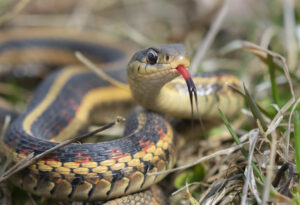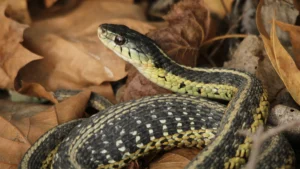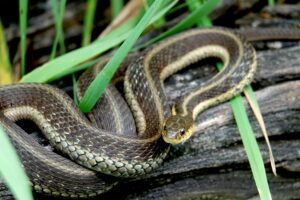What do baby garter snakes eat? It’s a question that might arise when considering these slender reptiles’ dietary needs. Baby garter snakes, like their adult counterparts, have specific preferences when it comes to their meals. Understanding their diet is essential for their health and well-being in captivity or in the wild.
From tiny insects to small vertebrates, the feeding habits of baby garter snakes offer a fascinating glimpse into the ecological niche they occupy. Let’s delve into the intriguing world of baby garter snake nutrition to uncover what keeps these pint-sized serpents satisfied.
What do baby garter snakes eat?

Baby garter snakes, like their adult counterparts, primarily eat small prey such as insects, worms, slugs, and small amphibians. These snakes are carnivorous, which means they rely on a diet of meat to survive and grow.
When baby garter snakes are newly born, they typically feed on tiny prey items that they can easily capture and consume. This might include small insects like crickets, grasshoppers, and caterpillars, as well as earthworms and small slugs. These prey items provide the necessary nutrients and energy for the young snakes to develop and thrive.
As they grow larger, baby garter snakes may begin to consume slightly larger prey. They might hunt and eat small frogs, toads, and salamanders, as well as small fish if they inhabit areas near water sources. Garter snakes are known for their adaptability and can even feed on larger prey relative to their size compared to some other snake species.
Overall, the diet of baby garter snakes consists of a variety of small, easily accessible prey items found within their natural habitat, helping them to grow and mature into healthy adult snakes.
Dietary Requirements for Baby Garter Snakes
Baby garter snakes, like all snakes, have specific dietary requirements to support their growth and development. Here’s a breakdown of the key nutritional needs for baby garter snakes:
- Protein: Protein is essential for the growth and repair of body tissues. Baby garter snakes require a diet rich in protein to support their rapid growth during the early stages of life. They obtain protein primarily from their prey, which includes insects, worms, slugs, and small amphibians.
- Calcium: Calcium is crucial for the development of strong bones and proper muscle function. Baby garter snakes need a sufficient amount of calcium in their diet to support skeletal growth and maintain overall health. Calcium is often obtained from the bones of their prey items or from calcium-rich supplements.
- Vitamins and Minerals: In addition to calcium, baby garter snakes require a variety of vitamins and minerals to support various physiological functions. This includes vitamins such as vitamin A, vitamin D, and vitamin E, as well as minerals like phosphorus and potassium. These nutrients are obtained through a diverse diet of prey items.
- Hydration: Adequate hydration is essential for all living organisms, including baby garter snakes. While garter snakes obtain moisture from their prey, they also require access to fresh water for drinking. Providing a shallow dish of clean water in their enclosure ensures that baby garter snakes stay hydrated.
- Frequent Feeding: Baby garter snakes have high metabolic rates and therefore need to eat frequently to support their energy needs and growth. They may need to eat every few days to every week, depending on their size and activity level. Offering appropriately sized prey items ensures that they receive an adequate amount of nutrition.
It’s essential to provide a balanced and varied diet to meet the nutritional needs of baby garter snakes. Additionally, monitoring their feeding habits and growth can help ensure that they are receiving proper nutrition.
If there are any concerns about their diet or health, consulting with a veterinarian experienced in reptile care is recommended.
Feeding Baby Garter Snakes in Captivity
Feeding baby garter snakes in captivity requires careful attention to their dietary needs and feeding habits. Here are some guidelines for feeding baby garter snakes:
- Prey Size: Offer prey items that are appropriately sized for the baby garter snake’s mouth. Prey should be no wider than the snake’s body at its widest point to prevent choking or regurgitation. For newborn baby garter snakes, start with very small prey items such as newborn mice, pinky mice, or small insects like crickets or mealworms.
- Frequency: Baby garter snakes have high metabolisms and typically need to eat more frequently than adults. Offer food every 3 to 5 days, adjusting based on the individual snake’s appetite and growth rate. Monitor their body condition to ensure they are neither underweight nor overweight.
- Variety: Provide a varied diet to ensure that baby garter snakes receive all the necessary nutrients. Offer a mix of live prey items such as insects (crickets, mealworms, waxworms) and appropriately sized rodents (pinkie mice). Variety not only ensures nutritional balance but also prevents picky eating habits from developing.
- Prey Presentation: Some baby garter snakes may prefer live prey, while others may accept pre-killed or frozen-thawed prey. Experiment with different presentation methods to determine what your snake prefers. When offering live prey, always supervise feeding to ensure the snake captures and consumes the prey safely.
- Hydration: Ensure that baby garter snakes have access to clean, fresh water at all times. Provide a shallow dish of water in their enclosure that is easy for them to access. Hydration is essential for digestion and overall health.
- Feeding Enclosure: Use a separate feeding enclosure for baby garter snakes to reduce stress and minimize the risk of substrate ingestion during feeding. A small plastic container with air holes works well as a feeding enclosure. Place the snake and prey item inside, and remove any uneaten prey after a reasonable amount of time.
- Monitor Growth: Keep track of your baby garter snake’s growth and adjust feeding accordingly. A healthy snake should steadily gain weight and show signs of growth with each shed. If you notice any changes in appetite, behavior, or growth rate, consult with a reptile veterinarian for guidance.
By following these guidelines and paying close attention to your baby garter snake’s feeding habits and nutritional needs, you can help ensure they grow into healthy adult snakes.
Considerations for garter snake feeding frequency and portion sizes

Feeding frequency and portion sizes for garter snakes, including baby garter snakes, depend on several factors including the snake’s age, size, species, metabolism, and individual appetite. Here are some considerations:
- Age and Size: Baby garter snakes have smaller stomachs and higher metabolic rates compared to adults. They typically require more frequent feeding and smaller prey items relative to their size. As they grow, their feeding frequency may decrease, and they can consume larger prey items.
- Metabolism: Garter snakes, in general, have relatively high metabolic rates, which means they require frequent meals to sustain their energy needs. Baby garter snakes, being smaller and more active, have even higher metabolic rates compared to adults. They may need to eat every 3 to 5 days, while adults may eat less frequently.
- Species Differences: There are several species of garter snakes, and their feeding habits may vary slightly. Some species may have more robust appetites or faster growth rates than others. Researching the specific species of garter snake you have can provide insight into their feeding requirements.
- Appetite: Individual garter snakes can vary in their appetite and feeding response. Some may be voracious eaters and readily accept food at every feeding opportunity, while others may be more selective or eat smaller portions. It’s essential to monitor your snake’s appetite and adjust feeding frequency and portion sizes accordingly.
- Prey Size: Offer prey items that are appropriately sized for the snake’s mouth. Prey items should be no wider than the snake’s body at its widest point to prevent choking or regurgitation. For baby garter snakes, start with small prey items such as pinky mice, newborn mice, or appropriately sized insects.
- Growth Rate: Monitor your snake’s growth rate and adjust feeding frequency and portion sizes accordingly. A healthy snake should steadily gain weight and show signs of growth with each shed. If growth seems stunted or excessive, consider adjusting feeding habits and consulting with a reptile veterinarian if necessary.
- Overfeeding and Obesity: Avoid overfeeding your garter snake, as obesity can lead to health problems such as fatty liver disease. Offer appropriately sized meals and monitor your snake’s body condition regularly. If you notice excessive weight gain or signs of obesity, reduce feeding frequency and adjust portion sizes accordingly.
- Consultation: If you’re unsure about the appropriate feeding frequency and portion sizes for your baby garter snake, consult with a reptile veterinarian or experienced reptile keeper for guidance. They can provide personalized advice based on your snake’s specific needs and circumstances.
By considering these factors and monitoring your baby garter snake’s growth and appetite, you can develop a feeding schedule and portion sizes that promote optimal health and growth.
Potential Challenges in Feeding Baby Garter Snakes
Feeding baby garter snakes can sometimes present challenges due to their small size, specific dietary requirements, and individual feeding preferences. Here are some potential challenges you might encounter when feeding baby garter snakes in captivity:
- Acceptance of Prey: Some baby garter snakes may be picky eaters or reluctant to accept certain types of prey. This can be particularly true during the initial stages of feeding. It may take some trial and error to determine which prey items your snake prefers, whether live or pre-killed, and to establish a consistent feeding routine.
- Prey Size: Ensuring that the prey items offered are appropriately sized for the baby garter snake can be challenging. Prey items should be small enough for the snake to swallow comfortably but large enough to provide adequate nutrition. Finding the right balance may require experimenting with different prey sizes and types.
- Feeding Response: Baby garter snakes may not always exhibit a strong feeding response, especially if they are stressed or in a new environment. Providing a quiet and secure feeding environment can help encourage feeding behavior. Additionally, offering live prey may stimulate the snake’s natural hunting instincts and increase feeding response.
- Hydration: Baby garter snakes, like all reptiles, require proper hydration for digestion and overall health. Ensuring that your snake has access to clean, fresh water at all times is essential. Dehydration can affect appetite and digestion, so it’s important to monitor your snake’s water intake and hydration status.
- Feeding Schedule: Establishing a feeding schedule that meets the snake’s nutritional needs without overfeeding or underfeeding can be challenging. Baby garter snakes have high metabolic rates and may require more frequent feedings compared to adults. However, feeding too often can lead to obesity or digestive issues. Finding the right balance may require monitoring your snake’s growth and adjusting feeding frequency accordingly.
- Regurgitation: Baby garter snakes are more prone to regurgitation than adults, especially if they are fed prey items that are too large or if they are handled shortly after eating. Handling should be minimized before and after feeding to reduce the risk of regurgitation. If regurgitation occurs frequently, it may indicate an underlying health issue that requires veterinary attention.
- Weight Management: Monitoring your baby garter snake’s weight and body condition is important for ensuring optimal health and growth. Overfeeding can lead to obesity and related health problems, while underfeeding can result in stunted growth and nutritional deficiencies. Adjusting feeding frequency and portion sizes based on your snake’s growth rate and body condition can help prevent these issues.
By being aware of these potential challenges and taking proactive measures to address them, you can help ensure that your baby garter snake receives the nutrition it needs to thrive in captivity. If you encounter persistent feeding difficulties or concerns about your snake’s health, don’t hesitate to seek advice from a reptile veterinarian or experienced reptile keeper.

Best Practices for Feeding Baby Garter Snakes
Feeding baby garter snakes requires attention to detail and adherence to best practices to ensure their health and well-being. Here are some guidelines for feeding baby garter snakes:
- Start with Small Prey: Begin by offering appropriately sized prey items that are small enough for the snake to swallow comfortably. Newborn baby garter snakes may start with tiny prey items such as newborn mice, pinky mice, or small insects like crickets or mealworms.
- Feed More Frequently: Baby garter snakes have high metabolic rates and typically need to eat more frequently than adults. Offer food every 3 to 5 days, adjusting based on the individual snake’s appetite and growth rate.
- Variety in Diet: Provide a varied diet to ensure that baby garter snakes receive all the necessary nutrients. Offer a mix of live prey items such as insects (crickets, mealworms, waxworms) and appropriately sized rodents (pinkie mice). Variety not only ensures nutritional balance but also prevents picky eating habits from developing.
- Monitor Feeding Response: Pay attention to your snake’s feeding response and adjust feeding methods accordingly. Some baby garter snakes may prefer live prey, while others may accept pre-killed or frozen-thawed prey. Experiment with different presentation methods to determine what your snake prefers.
- Preventive Measures: Minimize handling before and after feeding to reduce the risk of regurgitation. Handling can stress the snake and disrupt the digestive process. Provide a quiet and secure feeding environment to encourage feeding behavior.
- Hydration: Ensure that baby garter snakes have access to clean, fresh water at all times. Proper hydration is essential for digestion and overall health. A shallow dish of water should be provided in their enclosure and checked regularly to ensure cleanliness.
- Feeding Enclosure: Use a separate feeding enclosure for baby garter snakes to reduce stress and minimize the risk of substrate ingestion during feeding. A small plastic container with air holes works well as a feeding enclosure. Place the snake and prey item inside, and remove any uneaten prey after a reasonable amount of time.
- Monitor Growth and Body Condition: Keep track of your baby garter snake’s growth and body condition to ensure they are receiving adequate nutrition. A healthy snake should steadily gain weight and show signs of growth with each shed. Adjust feeding frequency and portion sizes as needed based on their growth rate and body condition.
By following these best practices and providing proper care and attention, you can help ensure that your baby garter snake grows into a healthy and thriving adult. If you encounter any difficulties or have concerns about your snake’s feeding habits or health, don’t hesitate to consult with a reptile veterinarian or experienced reptile keeper for guidance.
Conclusion
If you need clarity on what do baby garter snakes eat, then we’ve got you covered. Baby garter snakes primarily eat small prey such as insects, worms, slugs, and small amphibians. Their diet is essential for their growth and development, providing the necessary nutrients and energy. Feeding them a varied diet, monitoring their feeding habits, and ensuring proper hydration are crucial for their health and well-being as they grow into adulthood.

